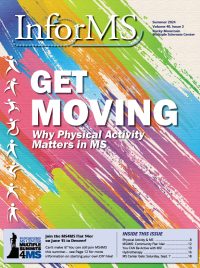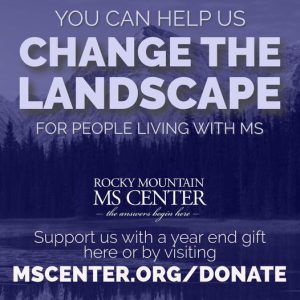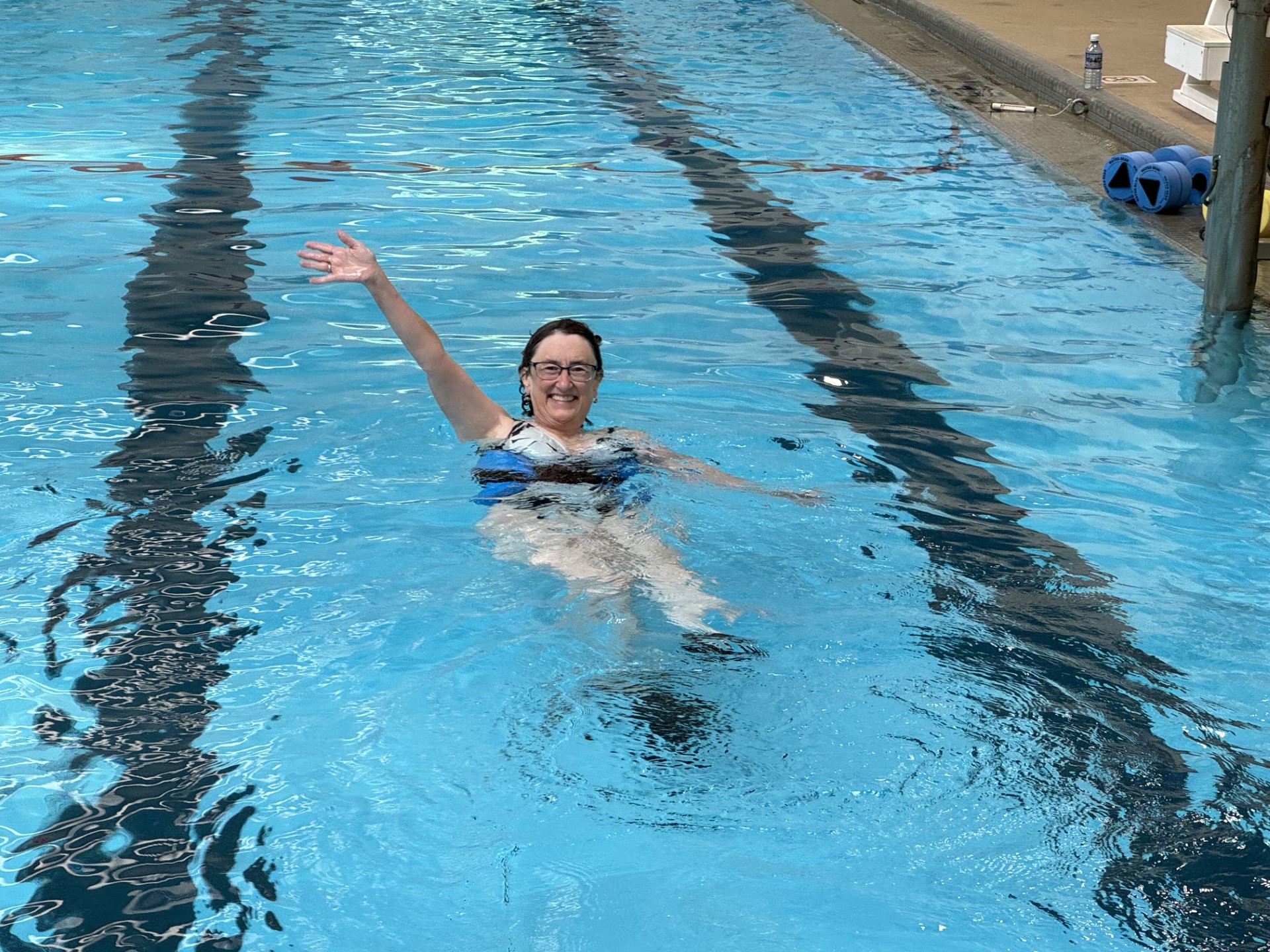
The Rocky Mountain MS Center began offering hydrotherapy classes for people living with MS and other neurological conditions in 1992. Michele Harrison, Rocky Mountain MS Center Hydrotherapy Coordinator and Licensed Physical Therapist, has provided Hydrotherapy classes to hundreds of people for more than 30 years.
Hydrotherapy is exercise in the water and includes stretching, balance activities, endurance work, and strength work for all parts of the body. What makes water special? Several key factors make exercise in the water particularly beneficial, including buoyancy, resistance, hydrostatic pressure, and temperature.
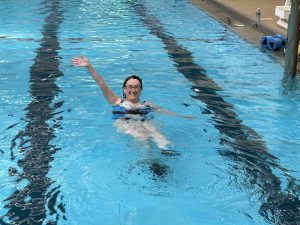
Hydrotherapy programs like the one offered by the Rocky Mountain MS Center can help people with movement, coordination, balance, and muscle issues stay active in an environment that naturally gives them additional support.
First, water provides a buoyancy, which is the uplift force you experience in the water. It makes movements towards the water’s surface easier and can include the ability to stand, walk, and be upright. Buoyancy reduces the effect of gravity, making you feel lighter in the water. This is why swimming can feel easier than many land-based exercises. This buoyancy reduces the stress on your joints, allowing for freer movement, especially for those with joint pain or injuries.
Water also offers beneficial resistance to movement. Moving through water requires pushing through this resistance, which helps to strengthen muscles and improve cardiovascular fitness. But unlike the resistance from weights or machines, water resistance is gentle and evenly distributed, reducing the risk of injury while also providing an effective workout.
When you’re in the water, something called hydrostatic pressure is exerted evenly over your entire body. Hydrostatic pressure is a property of water. Because of the sense of being compressed in the water, it can help with decreasing pain with joint weight bearing and upright postures. This may also improve standing and movement. This pressure helps to increase blood flow and circulation, reducing swelling and promoting healing in injured muscles and joints. Hydrostatic pressure can also have a calming effect on the nervous system, helping to reduce stress and tension, which allows for freer movement.
Water’s temperature can have therapeutic effects on the body. Warm water can help relax muscles and increase flexibility, making movement easier and more comfortable. Cold water, on the other hand, can reduce inflammation and numb pain, allowing for freer movement in individuals with conditions like arthritis or acute injuries. Cooler, not cold, water temperatures can help decrease heat sensitivity for people with MS. This may increase their ability to participate in more exercise or activity.
“The correct temperature is crucial for maximizing therapeutic benefit of the water,” explains Michele Harrison. “We utilize vests, caps and different equipment to keep people from feeling chilled in the water. Traditional hydrotherapy is done in a warm pool, which is too warm for most MS participants.”
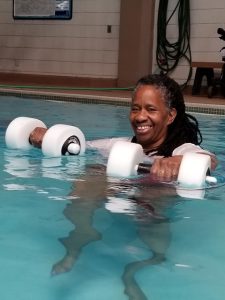
In the water, hydrostatic pressure is exerted evenly over your entire body — helping to increase blood flow and circulation, reduce swelling, and promote healing in injured muscles and joints.
Rehabilitation and wellness approaches like hydrotherapy have gained more attention and interest over the last several decades as the recognition of the importance of an active lifestyle for people living with MS has only increased. In part, that’s because an ever-growing body of research shows us that staying active and engaged in the community supports maximizing overall brain health and neurological reserve to increase the brain’s resilience and help slow the impacts of MS.
Many research studies demonstrate that exercise is a critical fuel for neuroplasticity — the brain’s ability to build new neural pathways to adapt to changing demands and maximize overall function. We know that exercise increases levels of brain-derived neurotropic factor (BDNF) and Nerve Growth Factor (NGF), and other growth factors increase the brain’s neurological reserve and ability to compensate for damage. While this extensive and ever-growing body of research is clear, the challenge for the majority of us is adopting an exercise program and then sticking with it. And it becomes even more difficult if you’re battling MS-related fatigue.
“We know that cardiovascular work increases BDNF and NGF in the brain which improve nervous system tissue protection, repair, and rejuvenation. So we often do cardio activities first to increase the neural-plasticity as we are doing strength, balance, posture, stretching and functional training throughout class,” says Michele. “One style of cardio training that has been proven to be effective is interval training, so we incorporate this approach as well.”
“We focus on incorporating movements to improve a person’s ability to perform daily activities — walking, balancing, transferring, and other daily activities,” explains Michele. And over the years, Michele has consistently incorporated new ideas and techniques to maximize the benefits of the exercise program for participants. “We know that interval training is important, so we always do our aerobic exercises before we do any strength training. Research tells us that chemicals are released when you are doing cardio work and that helps keep the brain as malleable as possible.”
Denise Van Huele’s sister Renée lived with Progressive MS for 30 years and was diagnosed when she was 29. When she was 45, she required a full-time live-in caregiver and couldn’t roll over in bed. Her mind and body were both dramatically impacted. “Renée had never been very active, and she resisted hydrotherapy when I would encourage her to try it,” says Denise. “She joked she thought I was trying to kill her! She finally relented and I joined her in the pool. It was less than 5 minutes and Renée looked me in the eye and said, ‘This is the best thing that ever happened to me.’
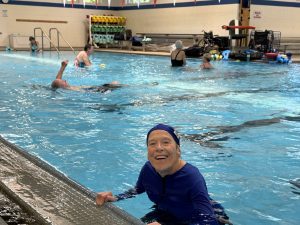
People with walking and mobility-related challenges often find that being in the water allows them to use parts of their body in ways that can’t easily be done normally. This promotes coordination, builds strength, and can even help rehabilitate some muscle and joints.
“We went most weeks and Renée’s confidence, strength, range of motion and attitude improved. With a life vest on we ‘swam’ laps. It was a very modified back stroke one direction and ‘snow angel’ going back. My job was to keep her going in a straight line! We regularly did 16 round trips, that is just shy of a half mile!”
Laura was diagnosed with MS in 1992. When she and her husband moved to Denver just last year, her neurologist recommended Hydrotherapy. “Hydrotherapy has been such a life-changing experience for me. I’d been a lap swimmer, using my arms with my legs just along for the ride, but hadn’t had any connection with others who had MS. I still swim, but I’ve also learned ways to exercise my legs and core in the water. Besides the added exercise, it has been wonderful to connect with so many others who have MS — the socialization has been such an added benefit. And my legs have strengthened. Hydrotherapy always reassures me that moving here was the right choice for me.”
Hydrotherapy offers a whole range of exercises that people can do — band work to strengthen arms and legs, aerobic exercises such as walking and powerwalking in the water. Everyone has different focus areas that they are working on, so there are many different pieces of equipment to meet individuals’ abilities and needs.
“I joined the RMMSC Hydrotherapy Program in September 2022,” says Francie, another participant. “Since that time, I have been amazed at the transformation of my physical, mental and emotional health! I am a stronger person and have built so many lasting friendships with my fellow participants. We truly are a little hydro family, and I am so grateful this program exists, and that I found it!”
Another Hydrotherapy participant named Mary shares: “Swimming is my favorite form of exercise. It makes my body light and free. It is a liberating feeling from the usual constraints of MS. I look forward to Hydrotherapy every week. Michele is wonderful with all of the participants. An added benefit is it’s a time to socialize and meet new friends.”
We are very grateful to have received a grant this year from the Christopher & Dana Reeve Foundation providing funding to support our Hydrotherapy Program. n
For more information about the RMMSC’s Hydrotherapy program, visit our website at MSCenter.org/hydro.


